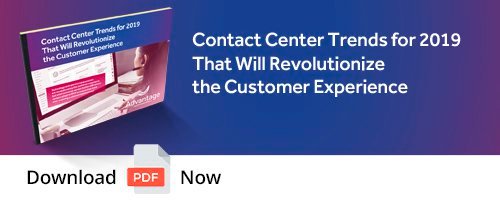
The customer service world has its own language - especially when it comes to outsourced call centers. Whether its words such as benchmarking or abbreviations such as NPS, these terms can be daunting for any new business owners that don’t have experience in creating customer service strategies.
The more of these customer service terms you know, the easier it will be for you to communicate with your whole organization and create strategies that will directly improve the customer service that your company offers.
Here at Advantage Communications, we know all too well just how confusing some of these terms can be. That’s why we’ve created the ultimate list of customer service terms, from a to z, and what they mean below:
Agents
A customer service agent provides service to customers either in person or via the phone. They answer calls, collect information from customers and resolve any customer queries and issues. The customer service agent helps to improve the customer experience (a term we explain later), and helps to create a loyal customer base.
Agent collision
This is the term for when two agents are viewing or updating the same ticket - this is easily avoidable by outsourcing your contact center to an expert. A professional solution will help you avoid agent collision and prevent duplication from simultaneous agent updates.
Agent console
This is the screen that agents see when they log in to their computer - it is the customer service homescreen. This is where agents access and manage their tickets.
Artificial intelligence (AI)
Not strictly a customer service term, but artificial intelligence (AI) is becoming an increasingly important tool in the bid to satisfy customers. Call center AI is being used to improve the service being offered by agents, as well as reducing customer effort and automating the way they are directed to information. One of the best examples of AI in customer service is the growing use of chatbots.
Average handle time (AHT)
This is the average time it takes an agent to hand and resolve a case from the very start to the very end. This includes everything from the initiation of the call, and includes hold time, talk time, related tasks and everything else.
Benchmarking
Benchmarking is an important word for any business, and a highly useful tool in customer service. In customer service, benchmarking is the simple act of measuring your individual or organization-wide performance against what your business hopes to achieve or pas performance. This will help your business constantly improve.
Big data
Big data is the information generated about your customers from web forms, artificial intelligence and interactions with customer service representatives. By analysing and making sense of this data, your company can make smart business decisions and leverage real-time data to offer unrivalled customer support help.
Want to learn more about how call centers are using big data? You can read about it on our blog, ‘Digital Transformation: How Customer Service Teams That use Real-Time Data are Winning the Customer Experience Battle’.
Bugs
This refers to any issue with your product that requires an engineer to fix the code - something you can avoid by outsourcing your contact center.
Case priority
This is the priority level assigned to each case to determine its level of important and how quickly it should be addressed.
Contact center
While people tend to use both contact center and call center interchangeably, here at Advantage Communications we believe there are a wide range of distinctions that set the two apart. While a traditional call center is more about answering calls and solving customer queries, contact centers are about improving your overall customer experience (CX) and making customer service a seamless process on any device.
Chatbot
A chatbot is a computer program that customers can talk to through either a chat window on a website, an app, or by voice. Chatbots have the ability to answer questions, creating a back-and-forth dialogue that is similar to that of a human representative. Techniques, such as machine learning, have allowed chatbots to become more accurate in predicting outcomes and directing users to the correct source of information.
Customer churn
Customer churn is the percentage of customers that stopped using your company's product or service during a certain time frame. This can be calculated by dividing the number of customers you lost during a specific time frame, by the number of customer you had at the beginning of that time period. This is a highly important metric as poor customer service is a major contributor to churn.
Customer experience (CX)
Customer experience is the interaction your organization has with its customer over the duration of your relationship. It’s likely that each customer will have a different experience, depending on what part of your company they have interacted with during their relationship - but the goal is to create a company-wide CX. A good customer experience will be a seamless, frictionless and satisfying journey that the customer wants (and expects) to experience again next time they buy a product.
Customer relationship management (CRM)
Customer relationship management (CRM) is a strategy that companies use to manage interactions with both current and potential customers. A CRM web-based platform gives your business access to real-time customer data, the ability to find customer service trends, a way to manage and evaluate customer service agents and much more.
Customer satisfaction score (CSAT)
CSAT is a way to predict customer loyalty, and can measure how happy or satisfied a customer is with your business, your product or your customer service interaction. A company's CSAT score is determined by asking customers a single question, a set of queries, or a long survey to assess their experiences. The answers are then quantified and expressed as a percentage between 0 and 100 percent. The higher the percentage the more satisfied your customers are with your company.
Customer service representative
A customer service representative, sometimes known as CSR, is the exact same role as a customer service agent. The terms are completely interchangeable.
Customer lifetime value (CLV)
CLV is an important metric as it provides a tangible link to revenue. Customer lifetime value is a prediction of the total profit your business can expect from any given customer over the entire period of the relationship. This can help your business to make important decisions around sales, marketing, product development, customer support and the user experience.
Want to improve your company’s CLV? Ready our blog, ‘4 Tactics to Increase Your company’s Customer Lifetime Value (CLV)’.
Helpdesk
An online or physical place where customers can access help for a specific problem they are experiencing. This could be anything from one person with a phone number, to a complex team that analyzes, resolves and tracks the issue.
Key performance indicator (KPI)
These are measurable values, or data-driven goals, that demonstrate how effectively your customer service team is delivering its objectives.
First call resolution (FCR)
FCR is a contact center’s ability to address the customer’s needs in a single contact, eliminating the need for the customer to follow up on their issue. Once first call resolution has been achieved the customer no longer needs to contact the contact center again about their resolution and a customer service representative will not need to follow up on the query. The issue is completely resolved.
Net promoter score (NPS)
NPS aims to find out how likely a customer will act as an ambassador of your brand, recommending your product or services to other people within their network. NPS simply asks the question: “how likely is it that you would recommend (company name) to a friend or colleague?” It then calculates this with a 0-10 scale, and groups respondents as follows; promoters, passives or detractors.
Omnichannel
Omnichannel customer service is a way of interacting with customers across multiple touchpoints, both before and after a sale. Simply put, an omnichannel approach to customer service is allowing customers to reach you on any platform and on whatever device is easiest for them.
Operational intelligence
Operational intelligence is a brand-new and revolutionary way of improving your company’s approach to customer service. By clearly displaying customer data and agent performance on screen, your business can make insightful and accurate business decisions that improve the customer experience.
Outsourcing
The word for engaging with a third-party vendor, such as ACI, to provide expert customer service support on behalf of your brand.
Queue
The current list of open tickets and customer queries that need attention from a customer support agent. These are usually sorted by a case priority number.
Self-service
Self service is a new approach to customer service that empowers your customers to answer their own queries and resolve their own issues. By providing high-quality content on your company’s website, your business can offer 24/7 customer service and immediate access to information that can resolve customer issues.
Service level agreement (SLA)
An agreement that describes the services that a provider offers a customer within a specific timeframe.
Support channel
This is the way that a customer could reach out to your brand for help - think phone, email, social media or a web form.
Support portal
A web channel that customers can log in to to create create cases, view their case history and find solutions.
Talk time
The time that a customer service agent spends talking to a customer on the phone to resolve an issue. Fast talk times are desirable, but fast call times alongside low FCR rates generally mean customers questions are not being answered correctly.
Time to resolution
This is the amount of time between the time a case is created and the time of the most recent resolution.
Troubleshooting
The process of trying to get to the root cause of a problem in order to find a solution.
Are you looking for more information about outsourcing your customer service to a call center in Canada, serving global clients? Contact the Advantage Communications team of experts today and we will be more than happy to help.



